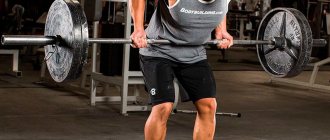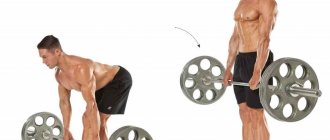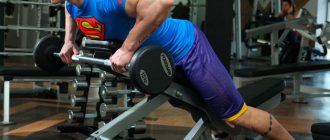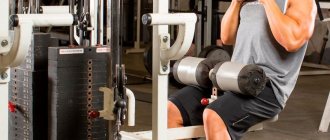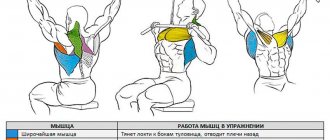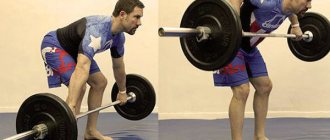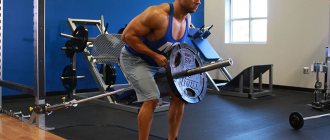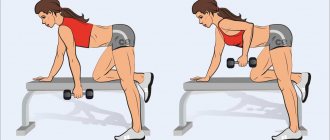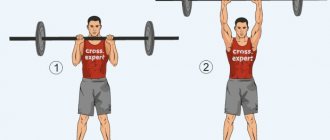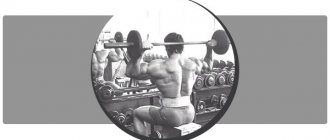In the halls where there were no fashionable Hummers and various blocky machines for all occasions, there were still strong guys with wide triangular backs. How did they do it? That's right, pull up with weights and perform bent-over barbell rows. By the way, for a natural athlete these two movements can be the main ones for many years. And if you are not a bodybuilder, but just want to become strong and healthy, this workout will give you everything you need. Bent-over barbell rows are part of the plans of ordinary athletes and powerlifting enthusiasts. This is a basic exercise that targets all the back muscles and allows you to develop strength.
Pros and cons of bent over rows
This is a complex exercise that involves several muscle groups. Thus, training using the exercise allows you not only to work out various muscle groups, but also to highly effectively train stabilizers and deep muscles, for example, spinal extensors and abdominal muscles.
The disadvantage of the exercise is considered to be a high risk of injury due to the lack of fixation of the spinal column. Lack of experience aggravates and increases the risk of serious injuries during the training process. This exercise requires adherence to technique and a gradual increase in working weight.
Bent-over barbell rows should not be performed with back and shoulder injuries.
The Importance of Stretching
The exercise places specific demands on form. Do you know why most men cannot bend forward normally? The reason here is not pain in the lower back, or even stiff hamstrings. The body position is usually stabilized by inflexible ankles. You will have to start the workout by stretching in a split squat with the heel of the back leg lowered to the floor. It is enough to stretch for 30-40 seconds on each side to make the bend more free.
Before training, it is also recommended to warm up the hip joints and shoulders with rotations. Otherwise, the tilt won't be deep enough to engage your back, and you won't be able to perform the movement correctly.
What muscles work when bent over?
- Latissimus dorsi muscles.
- Rhomboid muscles.
- Large round muscles.
- Posterior part of the deltoid muscles.
- Trapezius muscles.
- Back extensors.
- Biceps.
- Shoulder and brachioradialis muscles.
Choosing grip width
The traditional grip implies a right angle in the elbow joint when the barbell is pulled to the belt, but the grip can be changed to emphasize different muscles.
- The narrower the hands are on the bar , the more emphasis is placed on the work of the diamond-shaped ones;
- and with a wide grip, the teres major muscles, the back of the deltoid muscles, and also the trapezius muscles are involved in the work.
Tilt angle
The emphasis on some back muscles can be changed by tilting the torso.
- At a thirty-degree tilt, almost all back muscles are involved;
- and when the tilt changes to forty-five or fifty degrees , the muscles located in the upper back receive the load, namely: the trapezius muscles, the posterior deltoid muscles, as well as the teres minor and major muscles. Of course, the latissimus dorsi and rhomboid muscles are also involved during this exercise, but they work to a lesser extent.
The optimal tilt angle is considered to be close to thirty degrees.
Technique for performing bent-over barbell rows with a straight grip
In order to perform the exercise correctly, the best option for a beginner athlete is to train with light weights.
- The athlete must stand in front of the barbell with his feet shoulder-width apart.
- Your knees should be slightly bent.
- You need to grab the barbell with your palms shoulder-width apart, without bending your elbows, then straighten up. The starting position is as follows: the lower back is slightly bent, the torso is tilted forward. The tilt angle is approximately 30 degrees.
- Legs are bent at the knees. The lower back muscles should be tense.
- The starting point of the barbell amplitude is at the athlete’s knees, the end point of the amplitude is at the waist.
- During the initial movement, inhale, and when pulling the barbell to the belt, exhale, after which, during the reverse return movement to the starting position, inhale again.
- Throughout the entire movement, the elbows should move exclusively back and up, they should not diverge to the sides. The athlete should try to raise his elbows as high as possible.
- Traction is carried out only by the back muscles.
- Remember that the lower back muscles should be tense throughout the entire approach.
- Avoid cheating and jerking. The movement must be performed concentrated and smoothly.
- When performing bent-over barbell rows, your legs and head should remain motionless.
How is it different from horizontal rods?
Unlike horizontal rows performed on block machines, bent over rows are performed with free weights. This allows you to engage many other muscle groups to maintain postural stability.
In addition, if we compare bent-over rows and horizontal block rows, in the first case we use maximum weights in a limited range of motion. When working with a barbell, you will use heavier weights than in machines. And this will already lead to a more intense increase in muscle mass.
You can do bent over rows with or without a belt. It is important to understand here that by working without a belt, you force the lower back muscles to work to maintain the correct body position. If you don’t have any back problems or you don’t use too much weight, then it would be preferable to exercise without a belt.
Bent-over barbell row technique with a narrow reverse grip
This option is considered a more effective, but also more difficult exercise. An interesting fact is that it was invented by Dorian Yates himself! With a reverse grip, the load is placed on the lower latissimus dorsi muscles. Also, the muscles located in the center of the back are not excluded from the work.
When using a reverse grip, the amplitude increases. You can move your hands behind the body a little further. This technique allows you to reduce your back muscles as much as possible. The load on the lower biceps ligament also increases.
- In this case, your palms should be placed shoulder-width apart.
- The torso angle should be approximately 45 degrees.
- A bend in the lower back is necessary.
- The pelvis needs to be moved back a little. We start deadlifting from the level of the shins.
- Be sure to stretch the back muscles at the lowest point of the amplitude.
Benefits of Exercise
The incline row has a number of undeniable advantages that set it apart from other back exercises. These include:
- This exercise works better than any other exercise on the thickness of the lats, since you use heavy weights in the workout;
- Develops overall body strength and endurance. As you progress in this exercise, you will also improve in other strength exercises, such as the deadlift or barbell press;
- Improves flexibility and mobility of joints;
- Bent-over rows improve your posture and help train your back corset muscles;
- Intense calorie burning. By involving a large number of muscles in the work, the exercise helps improve metabolism.
Due to the rather unusual and sometimes complex technique, this exercise is not very popular among gym goers. Although its effectiveness is much higher than that of analogous exercises performed in simulators.
Features and technique of bent-over abdominal rows in the Smith machine
The Smith deadlift is performed using a technique similar to the classic exercise. The benefits of working in a Smith machine are obvious. This is an opportunity to fix the load at any point of the amplitude, as well as reduce the load on the stabilizer muscles, since in the simulator the movements are fixed by guides, due to which there are no swings and inaccuracies in movement. This option also allows you to perform the exercise more technically.
An excellent option for training the back muscles for beginner athletes is working in a Smith machine. However, it cannot be said that technically this option for performing traction is simpler.
- To begin with, you should set the bar of the exercise machine at hip level.
- You need to stand in the center and clasp the bar with your palms shoulder-width apart, place your feet hip-width apart.
- Next, you need to remove the bar from the clamps and tilt your body forward at 45 degrees and bend your knees.
- Your arms should be straight at the bottom of the movement.
- As you exhale, you need to stretch the bar to your waist, keeping your elbows close to your body. At the top of the movement, it is important to bring the shoulder blades to the center, contracting the back muscles.
- As you inhale, it is important to smoothly lower the bar to the lowest point, approximately to the middle of the shin. The main thing is not to throw the barbell down and not to swing your body.
- While performing the exercise, the knees and torso remain motionless.
Tips for maximum efficiency
- Movements should be smooth without jerking, both when lifting and lowering. Control the weight of the barbell and the work of your muscles.
- Raise your elbows as high as possible. This maximizes the use of your back muscles.
- Use all possible grips. This will add variety to your workouts and challenge your back muscles from different angles. Which will lead to their growth.
- Keep your brushes level. There is no need to twist them when you lift the barbell up. This will cause excessive stress on your hands. It will also reduce the trajectory of the barbell. Consequently, the back is not maximally loaded.
- Do not straighten your arms completely in the lower phase. This will protect your joints from strain.
- Do not use all kinds of back belts and special wrist straps. This will slow down your progress and prevent you from developing grip strength. It's better to take a lighter weight and work with it until your muscles get stronger.
- Work at full range. This way you can achieve maximum results and use more muscle fibers.
- Do not spread your elbows to the sides. This will change the emphasis of the impact from the back to the deltoids. Elbows move parallel to the body.
- Do not use “Cheating” (fixed repetitions), which are possible when using the lower body, that is, the legs and lower back. I wrote about this in the paragraph about errors.
- Be sure to use 1-2 warm-up approaches before the main ones. This warms up your muscles and prepares them for hard work.
Recommendations for performing standing bent-over rows with a barbell for men and women
This exercise is complex and energy-consuming, therefore, depending on the athlete’s level of training, it should be done first or second in the training process. Here is an example of a back workout using this exercise for a beginner athlete:
- Reverse grip pull-ups: 2-4x8-12.
- Wide grip bent over row: 2-4x8-12.
- Horizontal block thrust: 2-4x8-12.
- Hyperextension: 2-4x15-20.
Women can perform this exercise on a Smith machine. Rows can be combined with hyperextensions or reverse pull-ups in a superset. The optimal number of repetitions will be in the range from 20 to 25. You can limit yourself to two or three approaches.
To shift the load to the upper back, pull the barbell towards the chest area and spread your elbows to the sides. This version of the exercise is considered more difficult than the classic one.
General recommendations
- The position of the body must be fixed at the very beginning of the exercise and not change it until the end of the entire approach. This allows you to avoid overloading the lower back and direct all the load to the latissimus muscles.
- Try to keep your spine in a neutral position. To avoid losing control of your posture, you should not lower your head down.
- You must strive to move your elbows back as far as possible and touch the barbell with your body. This allows the muscles to contract as much as possible.
